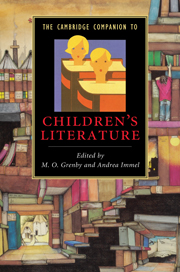Book contents
- Frontmatter
- Part I Contexts and Genres
- 1 The origins of children’s literature
- 2 Children’s books and constructions of childhood
- 3 The making of children’s books
- 4 Picture-book worlds and ways of seeing
- 5 The fear of poetry
- 6 Retelling stories across time and cultures
- 7 Classics and canons
- Part II Audiences
- Part III Forms and Themes
- Further reading
- Index
2 - Children’s books and constructions of childhood
from Part I - Contexts and Genres
Published online by Cambridge University Press: 28 November 2010
- Frontmatter
- Part I Contexts and Genres
- 1 The origins of children’s literature
- 2 Children’s books and constructions of childhood
- 3 The making of children’s books
- 4 Picture-book worlds and ways of seeing
- 5 The fear of poetry
- 6 Retelling stories across time and cultures
- 7 Classics and canons
- Part II Audiences
- Part III Forms and Themes
- Further reading
- Index
Summary
What do children know? How do they learn best? What rights should they have? All these fundamental questions about childhood can be contested (and frequently are). The framing of discussions about childhood are therefore influenced by the time and culture, as twentieth-century historians, anthropologists and sociologists have shown. How a person formulates responses to such questions, moreover, is also shaped by his or her perspective as an artist, biologist, economist, parent, philosopher or teacher. The issues at stake are not purely academic: whatever the answers, they are likely to have some impact on the way children are regarded and treated in a particular culture at a given time. A subsistence farmer in thirteenth-century France, a society where childhood mortality was extremely high and Roman Catholicism permeated all of life, would have had quite a different perspective on childhood from an upper middle-class father in Victorian England, whose children were likely to survive into adulthood but would bear the weight of dynastic, national and imperial expectations. Just as conceptions of childhood can differ sharply, so can ideas about children's books. The nursery rhyme anthology that delighted a mother in post-Second World War America might be condemned by an ardent communist in the Soviet Union of the 1920s as laughably deficient for training up the future citizens of the new society. But whatever the circumstances, there is no guarantee that children will accept the books adults press on them.
- Type
- Chapter
- Information
- The Cambridge Companion to Children's Literature , pp. 19 - 34Publisher: Cambridge University PressPrint publication year: 2009
- 2
- Cited by



